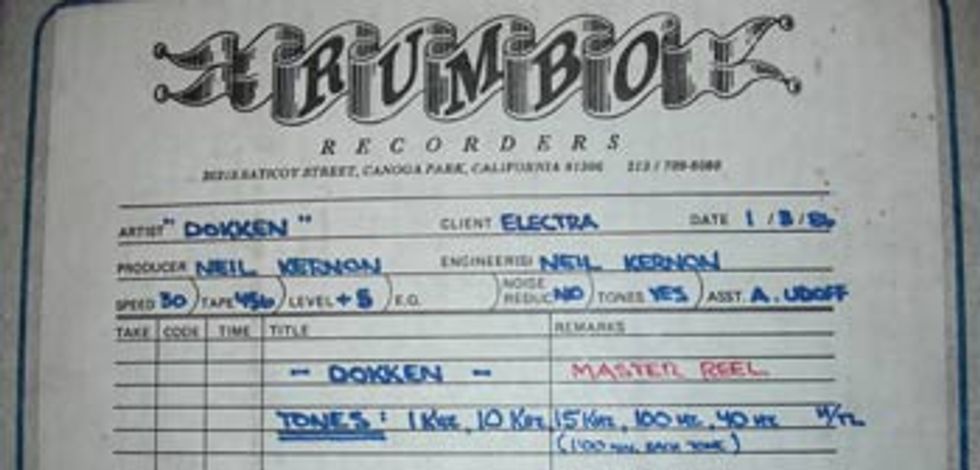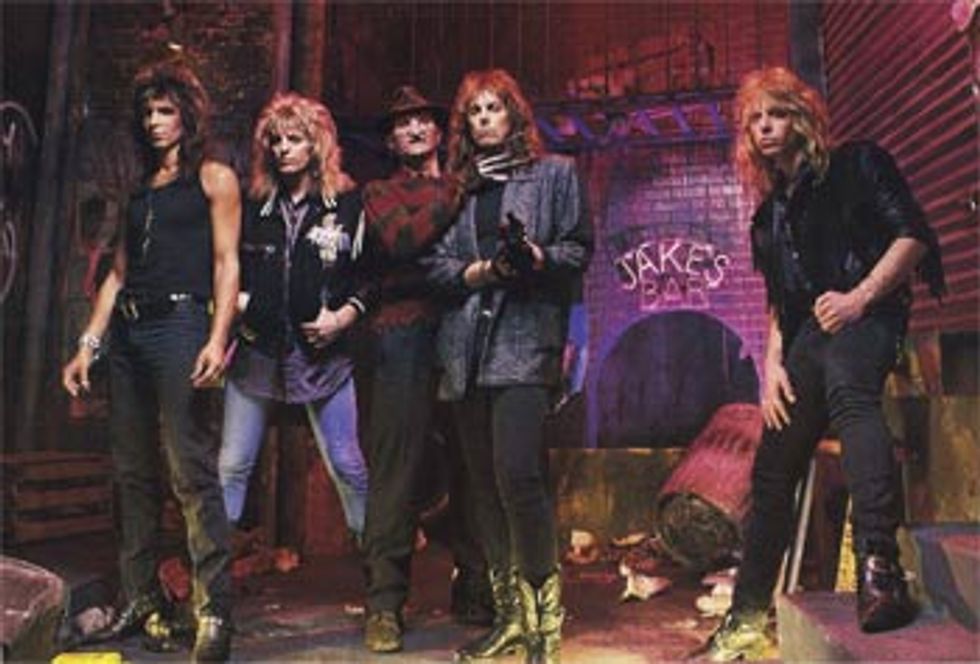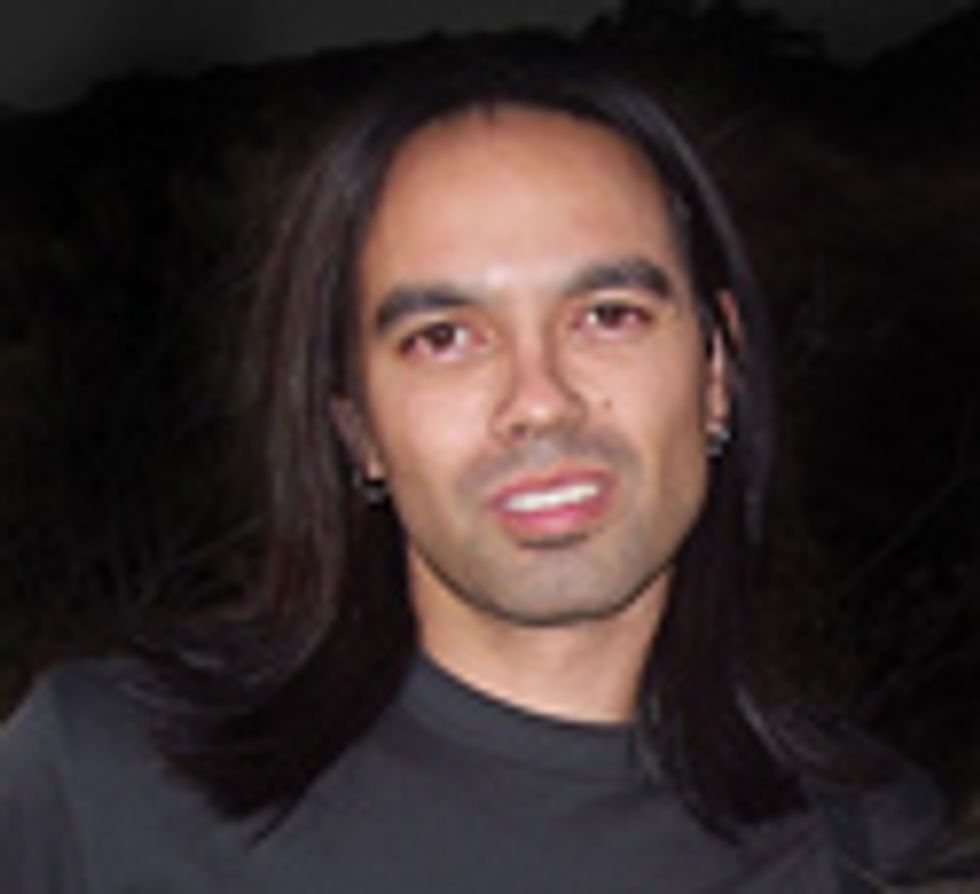| The sound engineers at OEM Inc. have spent thousands of hours with the original masters of the most famous songs ever recorded. They use them to create products like Jammit, an iPhone app that allows you to remix and play along with those original tracks. There are many, many things to learn from those original tracks. Through a partnership with Gearhead Communications, OEM Inc. engineers are sharing their discoveries exclusively with Premier Guitar readers in what we like to call Secrets of the Masters |
 "Dream Warriors" by Dokken
"Dream Warriors" by DokkenFrom the album, Back for the Attack (1987 Elektra)
Produced by: Neil Kernon
Engineered [Assistant]: Andy Udoff
Recorded at: Rumbo Recorders (Canoga Park, CA)
Available in the JAMMIT “80’s Rock Vol. 2” application
Daryl Dragon (the Captain of Captain and Tennille) boasted that his 10,000 square foot Rumbo Recorders recording studios nestled in the asphyxiating San Fernando Valley provided a low pressure and creative environment for his clients. Today the building is the kind of multipurpose hall that gets rented out for wedding receptions and bar mitzvahs, but in early 1987 that environment of supposed creative tranquility is where the metal band Dokken dug in to commit “Dream Warriors” to tape. A particularly heightened animosity between singer Don Dokken and guitarist George Lynch is well-documented during this period of the band’s history, leading fans to speculate if such fervor perhaps fueled the strident tones and fiery performances that would characterize the band’s sound. It should be noted that “Dream Warriors” was recorded for the Nightmare on Elm Street 3: Dream Warriors soundtrack. It was touched up and remixed months later when the band returned to the studio to record Back for the Attack, which is the band’s most successful record to date.
 A Nightmare on Saticoy Street?
A Nightmare on Saticoy Street?Let’s travel back in time 23 years by way of two Ampex 456 multi-track reels of analog tape. The place: Rumbo Recorders in Canoga Park, CA. The producer: Neil Kernon, who is most famous for producing Hall and Oats’ big albums. With Mike Clink wrestling Appetite for Destruction into fruition down the hall, Kernon kept Dokken’s volatile ingredients as separated as the 36 analog tracks that were used to capture “Dream Warriors.” Penned by Lynch and bassist Jeff Pilson, this song is quintessential Dokken but with the romantic-but-still-tough lyrics directed toward a scissor-fingered villain instead of a Sunset Stripper. What better place to wallow in the self-pity of those “lonely nights” and one’s thermal propensity to “feel the fire” than in a slasher flick soundtrack? This song might not be remembered for being a masterpiece of lyrical poetry, but the recording is a well-preserved time capsule of Lynch’s monster tone in 1987.
Andy Udoff must have had his hands full. Credited as assistant engineer on two highprofile records being recorded simultaneously under the same roof may account for some of the errors in the documentation for this song. Assuming he was responsible for labeling these things (as assistants typically were), the track sheets and the tape boxes were erroneously dated January of ’86 when it should have been for the following year. Apparently, sleep deprivation can cause an over-worked engineer to consistently misspell “warriors,” as well. It’s not unusual to have discrepancies in documentation with older tapes, and in a lot of cases finding the corresponding track sheets can be a victory in itself. So with all mislabeling aside, let’s spool-up the 2" machine and hear what went down on Saticoy Street.
Exhuming the Boom
The unprocessed drums sound remarkably good. Not only did Mick Brown deliver a solid performance, but the separation and fidelity far exceeded that of previous Dokken albums. Like many other rock bands back then, Dokken was on the cusp of a technology and sonic growth that saw significant improvement throughout the ’80s. This was most obvious in the drum sounds of the time. I found kick and snare room samples on the master tape to supplement the live drum performance. At that time, engineers commonly printed a pre-trigger by flipping the tape around to play backwards which allowed them to bounce the particular drum track to an available track through a delay unit. When the tape was played forward, that track would be gated and appropriately delayed in time to trigger the sample loaded in an AMS DMX 15-80 unit. This would have been a significant step up from having to get that overblown sound entirely from the natural drum kit, and much easier than recording Brown’s drums in an airplane hangar and then compressing/gating them in the studio off the master, which the band has been known to do.
Mr. Scary’s Sweet Revenge
George Lynch’s guitar tracks on “Dream Warriors” were a pleasure to hear in their raw state. His signature, chunky eighth-note chugs and unconventional chord inversions are the elements responsible for propelling this song into a fist-raising rock anthem. The primary axe for these sessions was Lynch’s original tiger. The pre-ESP original was a heavy maple-bodied strat-style guitar equipped with a single Duncan SH-6 Distortion pickup at the time. The amp was a purple 100-watt Marshall plexi owned by and rented from Groove Tubes’ Aspen Pittman. Refusing to sell the amp, Pittman frequently rented this amp to Lynch for sessions.
The main rhythm guitar parts were tracked in stereo from a single performance—either using two separate amps or just different cabinets. The stereo imaging of this pair is superb, with nice width in the higher frequencies tapering to the center for the lower midrange. This was due to separate mic placements in the room where a single Marshall 4x12 cabinet was situated. The phase relationship of these waveforms is impeccable and this explains why the guitars sound so full and aggressive in this song. These rhythm tracks are supported with a single mono guitar double. The clean arpeggiated guitars, which are another Lynch trademark, are layered with a thin, metallic-sounding DI acoustic guitar track.
 Photo by Neil Zlozower |
Unsung Hero
Don’s lead vocal was well recorded. Like the drums and guitars, the track was full of presence and tonal character that didn’t make it into the final, sloshy, ’80s-centric mixdown that we’ve all grown accustomed to hearing. While Don may be the front man after which the band is named, Jeff Pilson may be the unsung hero of this song. Jeff sang the guide chorus vocals on a scratch track that was used to build the 18-voice harmony layers constructed later on the tape. These were combined, consolidated to four tracks and were then placed into each chorus of the slave reel. Judging by that and a verse harmony track labeled as “Jeff” on the track sheet, I suspect that he may have sung most of these background vocals. Incidentally, his scratch bass take (that was most likely recorded live when the drums were done) was very well thought out and note-for-note pretty much what ended up on the master bass take.
The Bitter End
While Captain and Tennille may have professed that “Love Will Keep Us Together,” sadly, such was not the case with Dokken. “Dream Warriors” represents a career peak that was really just the beginning of the end for the band. Incarnations with different members and reunion attempts failed to recapture the magic of Dokken in their prime. Is it true that all good things must come to an end? Eventually, the significantly more popular Guns n’ Roses crumbled apart due to similar internal band problems and, as mentioned earlier, the very walls holding up what was once the infamous Rumbo Recorders recording studios are now absorbing endless refrains of “The Chicken Dance” and “Hava Nagila.”
Despite the traditional music industry’s decline and the seemingly irresolvable feuds of so many bands, the recorded music of groups like Dokken will outlive all the egos and attitudes that broke them apart in the first place. Evidence of their significance isn’t just immortalized in the mixes that we’ve come to know, the (nowdigitized) individual tracks of these master tapes tell a backstory of their creation that will outlive the bands themselves, and the fading memories of those who were involved in their creation.
To see/hear how you can play along to (with tab) and make new mixes of "Dream Warriors” and other songs from the original multi-track masters, check out www.jammit.com
 Frank Gryner is a multi-platinum
engineer whose credits
include bands like A Perfect
Circle, Matrix Soundtracks,
Rob Zombie, and Tommy Lee.
Frank’s technical expertise
in audio system design has
been applied to location studios for the likes of
Filter, Perry Farrell and John Paul Jones.
Frank Gryner is a multi-platinum
engineer whose credits
include bands like A Perfect
Circle, Matrix Soundtracks,
Rob Zombie, and Tommy Lee.
Frank’s technical expertise
in audio system design has
been applied to location studios for the likes of
Filter, Perry Farrell and John Paul Jones.Additional gear info provided by guitar tech and leading Lynchistorian Gerry Ganaden






![Rig Rundown: Russian Circles’ Mike Sullivan [2025]](https://www.premierguitar.com/media-library/youtube.jpg?id=62303631&width=1245&height=700&quality=70&coordinates=0%2C0%2C0%2C0)






















![Rig Rundown: AFI [2025]](https://www.premierguitar.com/media-library/youtube.jpg?id=62064741&width=1245&height=700&quality=70&coordinates=0%2C0%2C0%2C0)




















 Zach loves his Sovtek Mig 60 head, which he plays through a cab he built himself at a pipe-organ shop in Denver. Every glue joint is lined with thin leather for maximum air tightness, and it’s stocked with Celestion G12M Greenback speakers.
Zach loves his Sovtek Mig 60 head, which he plays through a cab he built himself at a pipe-organ shop in Denver. Every glue joint is lined with thin leather for maximum air tightness, and it’s stocked with Celestion G12M Greenback speakers.











